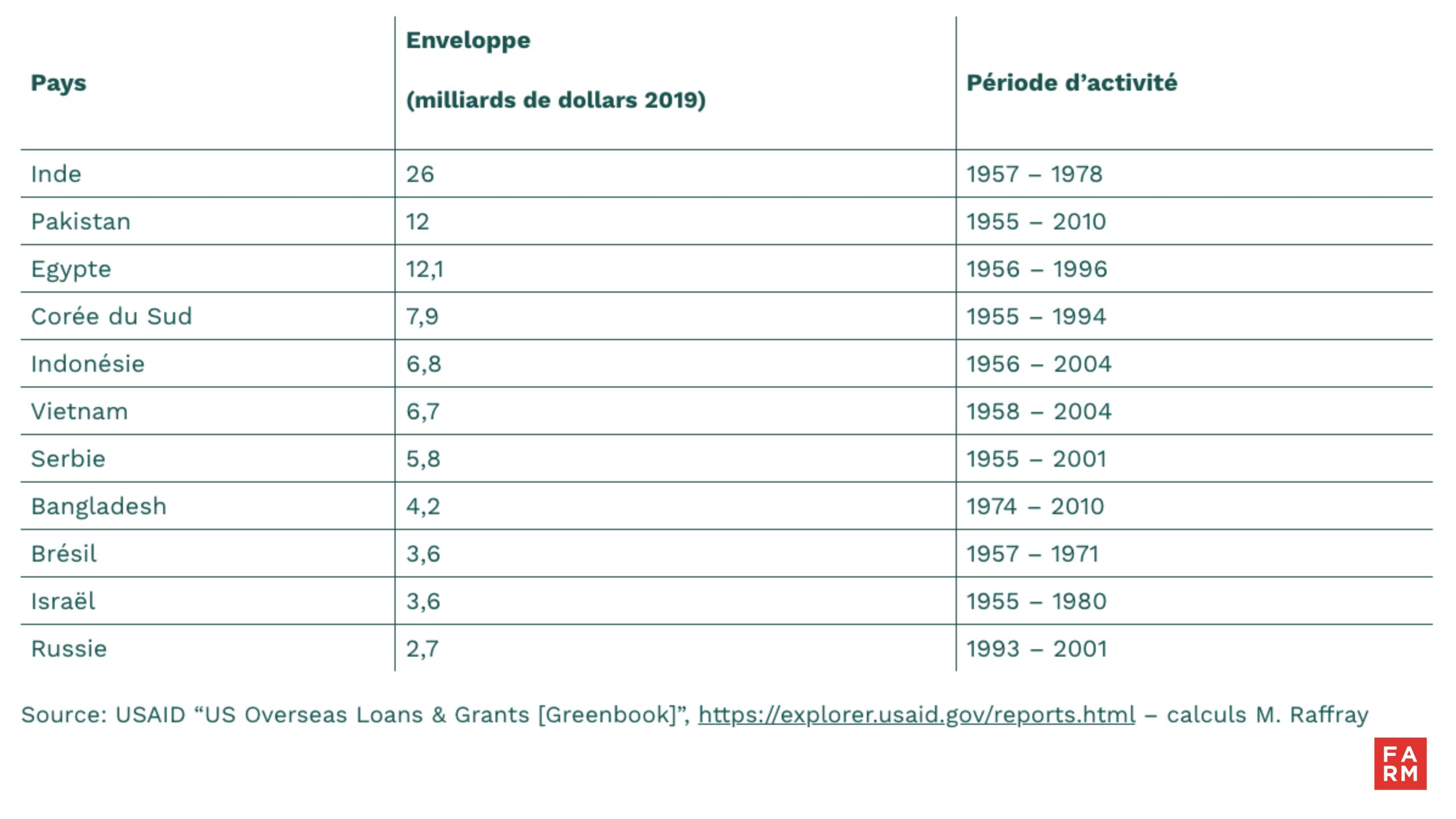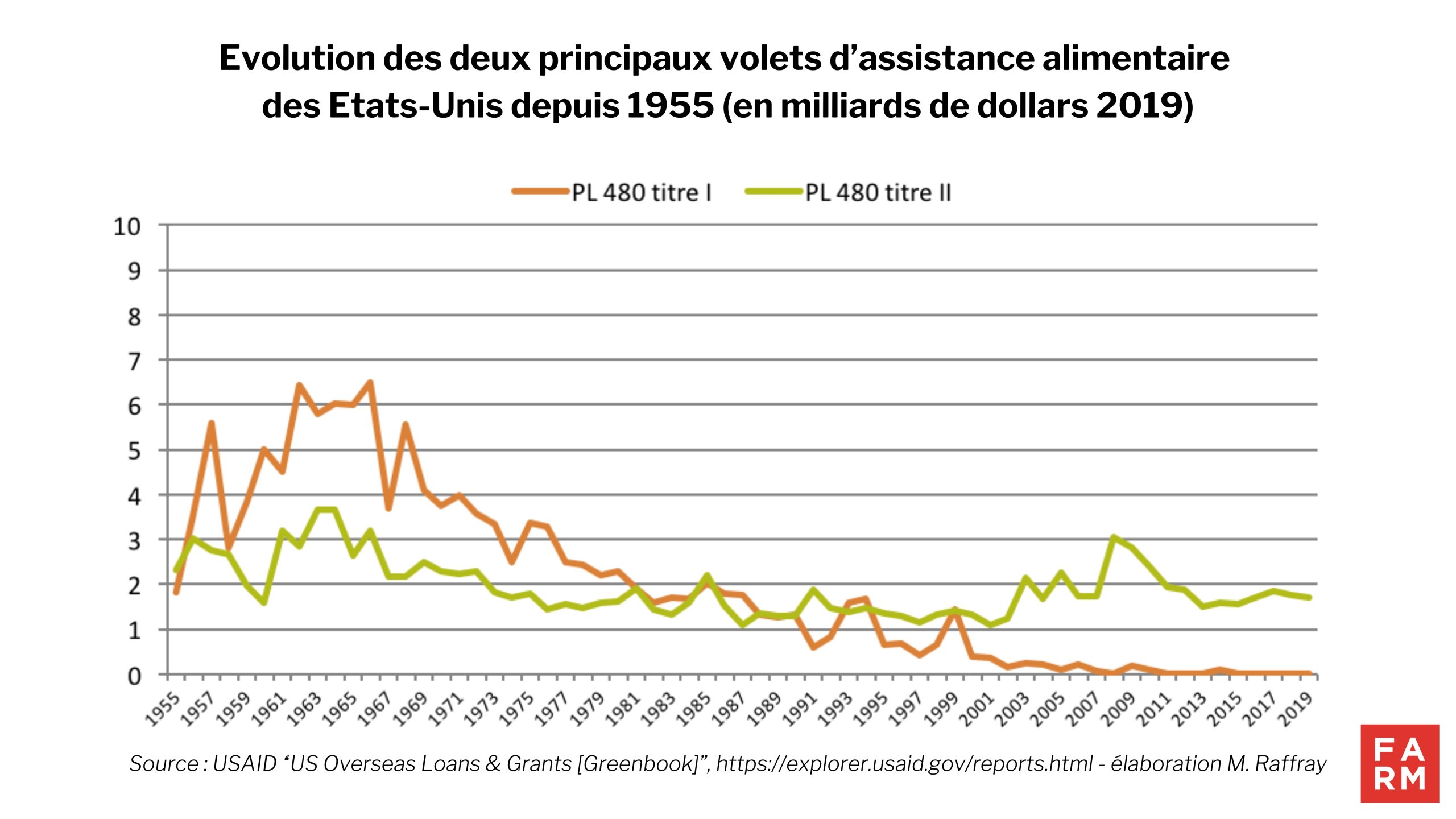Food aid as seen by the United States: when agriculture becomes an ambassador
The war in Ukraine, disruptions to global trade, and soaring agricultural prices all reveal the geopolitical dimension of food. While Russia's current position in global agricultural trade allows it to forge ties with importing nations, another country has successfully wielded the lever of agricultural exports: the United States, by building the most powerful international food assistance policy in the world.

A tool serving the American vision of world order
The two World Wars were pivotal events in the United States' awareness of the political role of food. In 1914, as Europe faced food shortages, the United States decided to ship American produce to the Old Continent to help the Allies hold out. This supply, financed by the Allied governments, continued after the Armistice was signed, amid fears of the spread of communism in a ravaged Europe.
At the end of the Second World War, the disastrous economic situation in Europe once again convinced the United States of the need to intervene. The motivations were both geopolitical—Washington feared that poverty would lead to revolutions and the rise of communism—and economic, in order to preserve Europe as the historic outlet for American agricultural surpluses. Indeed, the agricultural policy established in 1933 under President F.D. Roosevelt, which was based on guaranteed prices and public storage provided by the Commodity Credit Cooperation (CCC), has increased volumes and surpluses threaten to destabilize the agricultural sector. The Marshall Plan (1948-1951) will thus contribute to easing pressure on the markets: 70 % of the funds allocated to the United Kingdom, France, Italy, and West Germany, will be used by these states to acquire American foodstuffs and agricultural machinery.[1].
In 1949, while the revival of European agriculture was showing its first results, the United States was once again faced with difficulties in selling its surpluses. New outlets had to be created, and this would involve strengthening and perpetuating food donations to third countries with the implementation of the so-called Section 416(b) program, which relied on the mobilization of CCC public stocks to balance agricultural markets and support farmers.
The program Food for Peace
The reform of the 1954 Farm Bill will increase the export orientation of agricultural policy with the introduction of the Public Law 480 (PL 480), also known from 1966 as Food for Peace Act (FFPA). Between 1955 and 1969, exports under PL 480 and Section 416(b) averaged $1.2 billion annually, nearly a quarter of U.S. exports.
The FFPA is made up of four titles which cover programs with different operations:
- Title I, The main program between 1955 and 1989, consisted of the sale on credit of American agricultural products to governments or private entities in the form of long-term loans at interest rates below those of the market, for resale in the recipient country. India, Pakistan and Indonesia were among the main recipient countries, particularly during the Cold War, the United States identifying them as critical countries to support to avoid a shift into the Soviet or Chinese camps[2].
Main beneficiary countries of Title I

- THE Title II, which became the main program from the 1990s onwards, consists of donations of American food for emergency or food assistance purposes. In the latter case, the beneficiaries (NGOs, cooperatives, intergovernmental organizations such as the World Food Program[3]) can carry out direct distributions or resell the food.

- Title III : in-kind donations to governments of countries below a certain income level. This title has been inactive since 2002.
- THE Title IV: The Farmer-to-Farmer Program, launched in 1985, funds technical assistance projects led by American volunteers with farmers or businesses in developing countries. This program represented only $15 million, or 0.6 billion of the FFPA funds between 2014 and 2018.
New Paradigm of Food Aid
While food assistance has so far relied on in-kind aid, another mechanism, the Emergency Food and Shelter Program (EFSP) will be implemented. This involves financial aid: vouchers, cash transfers to target populations, or even the purchase of food by the United States on the markets of beneficiary countries. The EFSP is an emergency food security program, enshrined in law in 1961 but only implemented in 2010, in the context of the war in Syria. It currently represents the most endowed axis of food aid.
Other food aid programs exist such as Food for ProgressThis is a program of donations of American agricultural products for resale to finance development projects. The recipient country must in return engage in agricultural policy reforms favoring "free enterprise," reflecting the link between assistance and influence.[4].
The Bill Emerson Fund is a financial or in-kind reserve intended to be mobilized quickly in the event of a humanitarian crisis. This reserve was mobilized in April 2022 to replenish an emergency food aid fund. $670 million to address soaring food prices[5], for Ethiopia, Kenya, Somalia, Sudan, South Sudan, and Yemen ($282 million to acquire food in the United States and $388 million to transport it...).
Food assistance made in USA
These programs reveal intangible characteristics of U.S. food aid.
First of all the persistence of in-kind donations, even if their share has decreased (nearly 2.1 million tonnes in 2021, mainly cereals and oilseeds[6]). The American origin of the food is imposed by law. Then, the use of food assistance for generate positive spinoffs for the American economy is assumed. In addition to the American origin of the distributed foodstuffs, at least 50 % of the volumes must be transported by American ships and at least 50 % of the whole grains transported in bags must be packaged in the United States. Finally, food aid is closely linked to agricultural policy, which has relied on agricultural surpluses collected by the CCC. Thus, the volumes and composition of the products distributed have varied over time and the amounts of the assistance programs are rediscussed every four years, during the reforms of the Farm Bill.
Internal and external criticism
In-kind food aid has been seen, even internally, as an obstacle to the establishment of an agricultural sector in recipient countries, through competition from its free or cheaply resold food, or by discouraging local governments from investing in agriculture, keeping them on American life support for decades.[7]. In order to prevent the risks of destabilization of agriculture in third countries, donations have normally been prohibited since 1977 if there is a risk of disruption to agricultural production in the beneficiary country. In 2017, the Government Accountability Office criticized the United States Department of Agriculture (USDA) and the United States Agency for International Development (USAID), stressing that they had not sufficiently analyzed the effects of their actions on the agricultural markets of beneficiary countries.[8].
The link to agricultural surpluses has generated criticism regarding the variability of the quantity of aid, the nutritional value of the foodstuffs, and even their suitability for the eating habits of the target populations – like refined wheat flour, cheese, or even infant formula.[9].
The strength of US food assistance has also drawn criticism in the discussions of the Doha Round under the aegis of the World Trade Organization (WTO). And for good reason, Article 10, paragraph 4 of the 1994 Agreement on Agriculture, which concerns the prevention of circumvention of export subsidy commitments, stipulates that:
“Members providing international food aid shall ensure: (a) that the provision of international food aid is not linked directly or indirectly to commercial exports of agricultural products to recipient countries; […] (c) that such assistance be provided as far as possible entirely in grant form or on terms no less favourable than those provided for in Article IV of the 1986 Food Aid Convention.[10]
The United States' compliance with this article is open to question. Debates surrounding the nature of food aid are recurrent, with the tendency being to direct the use of funds towards grants to recipient states rather than in-kind donations.[11]The United States, which remains by far the largest contributor to global food aid, continues to devote 41% of aid to food donations, even if this share has decreased (Title I, for example, has been inactive since 2006).[12].
Food aid, combined with a strong agricultural policy, helped place the United States at the center of the post-World War II global chessboard, by selling surpluses on world markets and in countries dependent on imports to supply their populations, particularly during conflicts.[13]Agricultural surpluses, which could have destabilized the American agricultural sector, were ultimately mobilized to strengthen the country's political and economic influence internationally.
A strategy reminiscent of that adopted by Russia at the turn of the 2000s, of which wheat is the most illustrious example. While in the 1990s the country was structurally an importer of wheat (more than 4.7 million tonnes imported on average per year), it became a net exporter from 2001, thanks to the revival of the agricultural sector with state support. In 2021, Russia exported 27 million tonnes of wheat, and now imports only an insignificant volume of a few tens of thousands of tonnes per year. Nearly 44,% of production is exported. Over the years, the customer countries for Russian wheat have diversified. Today, they are mainly Turkey, Iran, Kazakhstan, but also countries in the European Union, the Arabian Peninsula, West Africa, Southern Africa, and the Horn of Africa. The strategic role of agricultural exports is claimed by Russia, and mobilized in the light of the conflict opposing it to Ukraine to create economic and political alliances.
[1] Tarnoff C. (2018), The Marshall Plan: Design, Accomplishments, and Significance, Congressional Research Service Report
[2] Ahlberg KL (2007), “Machiavelli with a Heart: The Johnson Administration's Food for Peace Program in India, 1965–1966”, Diplomatic History, Vol. 31, No. 4
[3] The United States is by far the largest contributor to the WFP.
[4] Schnepf R. (2016), US International Food Aid Programs: Background and Issues, Congressional Research Service Report.
[5] https://www.usaid.gov/news-information/press-releases/apr-27-2022-biden-administration-announces-hundreds-millions-dollars-global-food
[6] USDA (2022), International Food Assistance Report – Fiscal Year 2021; USAID (2022), International Food Assistance Report – Fiscal Year 2021
[7] Epstein BS (1984), Primer on PL 480 – Program History, Description, and Operations: a Brief Compilation of Explanatory Documents, Congressional Research Service Report; General Accounting Office (1994), Public Law 480 Title I: Economic and Market Development Objectives Not Met, Testimony Before the Subcommittee on Economic Policy, Trade and Environment, Committee on Foreign Affairs, House of Representatives.
[8] General Accounting Office (2017), International Food Assistance, Agencies Should Ensure Timely Documentation of Required Market Analyzes and Assess Local Markets for Program Effects, Report to the Chairman, Committee on Agriculture, House of Representatives.
[9] Epstein BS (1984), op cit.
[10] https://www.wto.org/english/docs_e/legal_e/14-ag_02_e.htm
[11] World Trade Organization (2018)), Implementation of the Decision on Measures concerning the possible negative Effects of The Reform Program on Least Developed and net food-importing Developing Countries, Note by the Secretariat.
[12] Casey AR, Morgenstern EM, (2021), US International Food Assistance: An Overview, Congressional Research Service Report.
[13] Friedmann H. (1982), “The Political Economy of Food: The Rise and Fall of the Postwar International Food Order”, American Journal of Sociology, January 1982.
